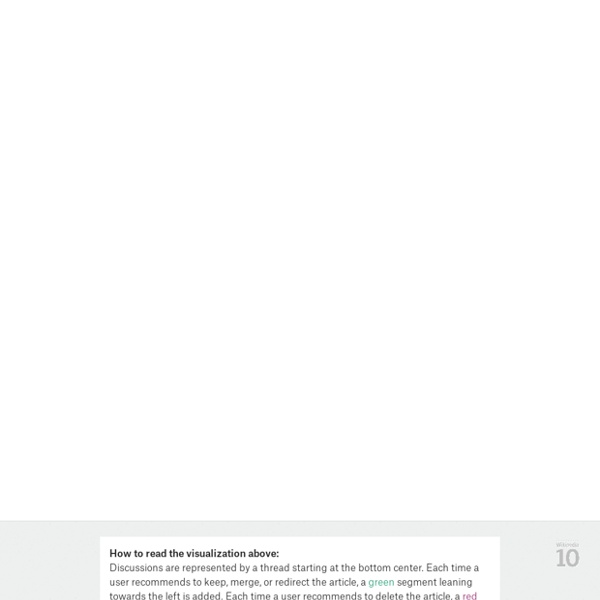



history flow In the Visualization and Behavior Group we take the perspective that data visualization should make data analytics accessible to anyone, not just the data's experts. We also believe that using social software for communication is the new norm, not a trend. We ask questions related to this world where people communicate through social media and gain insight into their world with data visualization. Our group builds innovative visual interfaces, designs novel user experiences for exploring analytics, and analyzes users' behavior in terms of motivations, incentives, and cultural influences. Some questions that keep us up at night: What does it take to trust the results shown in a visualization? Previous Projects
Norse Attack Map Open textbook An open textbook is a textbook licensed under an open copyright license, and made available online to be freely used by students, teachers and members of the public. Many open textbooks are distributed in either print, e-book, or audio formats that may be downloaded or purchased at little or no cost.[1] Part of the broader open educational resources movement,[2][3] open textbooks increasingly are seen as a solution to challenges with traditionally published textbooks, such as access and affordability concerns.[4] Open textbooks were identified in the New Media Consortium's 2010 Horizon Report as a component of the rapidly progressing adoption of open content in higher education.[5] Usage rights[edit] The defining difference between open textbooks and traditional textbooks is that the copyright permissions on open textbooks allow the public to freely use, adapt and distribute the material. Open licenses[edit] Some examples of open licenses are: Affordability[edit] Higher education[edit]
Total Dick-Head Strange Horizons - Estrangement and Cognition By Darko Suvin Darko Suvin is one of the most important critics of science fiction. His work on science fiction as a literature of cognitive estrangement was one of the first major academic engagements with the genre, and has proved both enduring and influential; he has received the SFRA Pilgrim Award for his contributions to SF scholarship, and dialogue with his ideas continues in the criticism of Frederic Jameson, Carl Freedman, Istvan Csicsery-Ronay Jr., and others. The essay reprinted here, "Estrangement and Cognition," is one of the earliest statements of some of Suvin's core theses. Author's note, 1979: The first version of this essay emerged from a lecture given in Spring 1968 in J. Contents 1. 1.1. In this chapter, I will argue for an understanding of SF as the literature of cognitive estrangement. 1.2. From Iambulus and Euhemerus through the classical utopia to Verne's island of Captain Nemo and Wells's island of Dr. 1.3. 2. 2.1. 2.2. 2.3. 2.4. 2.5. 3. 3.0. 3.1. 3.2. 3.3. 4. 4.1. 4.2. 5. 6.
JOHN C Programming and Metaprogramming in THE HUMAN BIOCOMPUTER All human beings, all persons who reach adulthood in the world today are programmed biocomputers. None of us can escape our own nature as programmable entities. Literally, each of us may be our programs, nothing more, nothing less. Despite the great varieties of programs available, most of us have a limited set of programs. Some of these are built in. Eventually the cerebral cortex appeared as an expanding new highlevel computer controlling the structurally lower levels of the nervous system, the lower builtin programs. -John C. Also by John C. JOHN C. New York A11 rights reserved including the right of reproduction in whole or in part in any form. Copyright (31967, i968 by John C. Library of Congress Catalog Card Number 7379777 Reissued in revised format, 1972, by The Julian Press, Inc., Publishers 150 Fifth Avenue, New York, N. Manufactured in the United States of America Design & Composition by Freda Browne, New York February 7, 1972
Mood Organ by Philip K. Dick from Do Androids Dream of Electric Sheep? It is not clear, from the novel, exactly how the mood organ works. It seems to produce some sort of wave that acts selectively on different parts of the brain; the heart of the device is the Penfield Wave Transmitter. In this excerpt, Rick Deckard is having an argument with his wife, and is looking for the right "tune" from his mood organ. Do Androids Dream of Electric Sheep is a novel that makes use of androids (created beings that are organic, and are essentially identical to people). During the course of the novel, the reader is often moved have feelings about these artificial beings, and then forced to compare their feelings toward the "real" humans. Here is another quote that shows how the mood organ is used: 'So I left the TV sound off and I sat down at my mood organ and I experimented. My favorite setting for the mood organ is 888, which creates the desire to watch TV no matter what is on. Comment/Join this discussion ( 5 ) | RSS/XML | Blog This | Articles related to Culture
Reading and Writing Yourself to Gnosis: Philip K. Dick and the Exegesis – Evolve + Ascend Philip K. Dick is a writer for our time. This is a statement that we could make just as easily in 1982, the year he died, as we can today. Today, P.K.D. is everywhere heralded as one of the literary greats of our our recent era; right up there with any members of the so-called Western canon. Then there’s 2017’s Blade Runner: 2049, which, while it didn’t break the box office, was heralded by many critics as a film that raised science fiction to high cinematic art, rife with haunting imagery of the Anthropocene: a future riddled by technological devastation and climate change. They say art imitates life, but from P.K.D.’s perspective, that can go both ways. He was, in other words, a prophet in the real sense of the word: a seer, soothsayer, and bard. These experiences weren’t easy. The (Cosmic) Fish From The Religious Experience of Philip K. It was in 1974, 2-3-74, to be exact, when he had what can only be described as a visionary encounter. Dick writes about it later in The Exegesis: